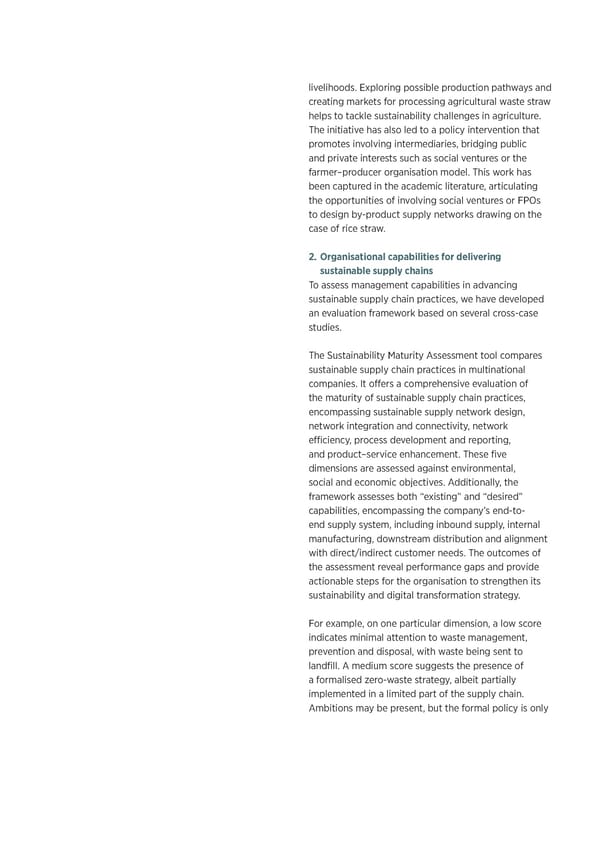SUSTAINABILITY SPOTLIGHT | 48 Below we explore four areas of our work in this space. livelihoods. Exploring possible production pathways and creating markets for processing agricultural waste straw 1. Using renewable resources for sustainable helps to tackle sustainability challenges in agriculture. production The initiative has also led to a policy intervention that By leveraging expertise in supply chain design, our promotes involving intermediaries, bridging public team has looked at how renewable feedstocks can be and private interests such as social ventures or the more extensively used in manufacturing supply chains. farmer–producer organisation model. This work has While using resources e昀케ciently, we aim to minimise been captured in the academic literature, articulating waste and reduce environmental impact. For example, the opportunities of involving social ventures or FPOs we have created new methods to consider alternative to design by-product supply networks drawing on the feedstocks as a supply-driven matter rather than case of rice straw. determined by customer demand. In the context of renewable feedstock, our process involves evaluating 2. Organisational capabilities for delivering the feedstock’s characteristics and technology options sustainable supply chains for converting it into primary and secondary raw To assess management capabilities in advancing materials for speci昀椀c markets. sustainable supply chain practices, we have developed an evaluation framework based on several cross-case An example of this concept is the use of terpenes as studies. sustainable chemical feedstocks currently sourced from the petrochemical industry. Terpenes are natural The Sustainability Maturity Assessment tool compares compounds found in citrus, turpentine and pine oils, sustainable supply chain practices in multinational but they are also available as by-products of industrial companies. It o昀昀ers a comprehensive evaluation of production. They can be converted into chemical the maturity of sustainable supply chain practices, feedstocks and o昀昀er an alternative to current fossil encompassing sustainable supply network design, fuel sources, transitioning to renewable resources. network integration and connectivity, network This transition potentially o昀昀ers several bene昀椀ts, e昀케ciency, process development and reporting, including new sustainable manufacturing processes, and product–service enhancement. These 昀椀ve reduced feedstock costs, increased supply security and dimensions are assessed against environmental, minimised environmental impact. social and economic objectives. Additionally, the framework assesses both “existing” and “desired” Another example of using by-products of industrial capabilities, encompassing the company’s end-to- processes has been our work conducted in a major end supply system, including inbound supply, internal research project, project TIGR2ESS, a collaboration manufacturing, downstream distribution and alignment between Cambridge and India, and more recently with direct/indirect customer needs. The outcomes of Pakistan. The project, funded by the Global Research the assessment reveal performance gaps and provide Challenges and Cambridge Newton Funds, involved actionable steps for the organisation to strengthen its exploring the feasibility of alternative supply networks sustainability and digital transformation strategy. and public–private partnerships to produce, at scale, primary agri-production, but also the reprocessing of For example, on one particular dimension, a low score by-products into value-added products. indicates minimal attention to waste management, prevention and disposal, with waste being sent to For instance, we have worked on transforming localised land昀椀ll. A medium score suggests the presence of circular supply networks that use post-harvest rice a formalised zero-waste strategy, albeit partially straw stubble – currently burned on-site to clear the implemented in a limited part of the supply chain. 昀椀elds, leading to signi昀椀cant air pollution in the region Ambitions may be present, but the formal policy is only – into revenue-generating industrial products from partially implemented in a factory setting. A high score what was previously considered waste. Discovering indicates a focus beyond the factory – for example alternative uses for such waste not only solves the adopting circularity principles and considering the waste-management challenge burdening farmers and entire product life cycle, including using renewable the local community but can also assist in reducing energy in production. On the product side, actively emissions, lowering air pollution and improving pursuing repair, recycling and refurbishment may also be indicated.
 Sustainability Spotlight Magazine Page 47 Page 49
Sustainability Spotlight Magazine Page 47 Page 49